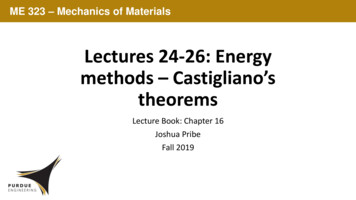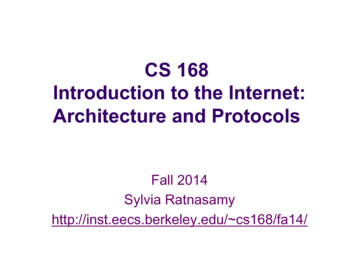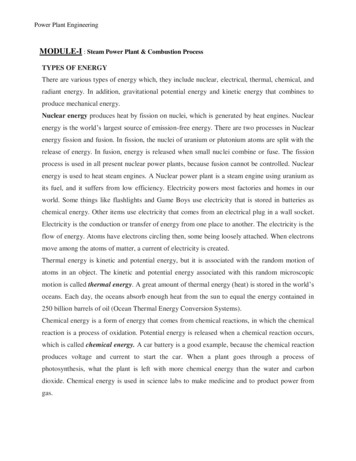
Transcription
ME 323 – Mechanics of MaterialsLectures 24-26: Energymethods – Castigliano’stheoremsLecture Book: Chapter 16Joshua PribeFall 2019
Course outline Part 1: Overview of concepts Static equilibrium Stress and strain Mechanical properties of materials Part 2: Types of deformation Axial deformation Torsion Bending Part 3: Combined loading Energy methods – deformation due to combined loading Stress due to combined loading Failure theories2
Objectives Calculate the strain energy stored in elastic bodies Calculate the work done by external forces and moments Use the strain energy to calculate displacements and rotations Work-energy relationship Castigliano’s theorem3
Strain energyLecture Book: Ch. 16, pg. 6-7Strain energy density: energy per unit volume stored in an elastically-deformed body1u x ( x T ) y ( y T ) x ( z T ) xy xy xz xz yz yz 2Total strain energy: integrate over the volume of the body: U udVVGoal: use what we know about stress and strain from each type of deformation to determinethe strain energyExample: axially loaded rodL, A, EP4
Work done by external loadsLecture Book: Ch. 16, pg. 6uA AuAW ( PA )1 PA du PAu A20W (TA )1 TA d TA A20W (M A ) A M Ad 0W ( PC ) vC PC dv 0Linear elasticdeformation dueto a force:1M A A21PC vC2Linear elasticdeformation due to amoment or torque:uAu5
Lecture Book: Ch. 16, pg. 10-11U 2 d u 1EI 2 dx 2 0 dx L2Work-energy relation: all of the work done on an elastic body is stored as strain energy:W U6
ExampleFind the vertical deflection at point B using the work-energy relationship.The beam has Young’s modulus E and second area moment I.Neglect shear strain energy due to bending.PLBA7
Castigliano’s theorem: Determinate structuresCastigliano’s Second Theorem Lecture Book: Ch. 16, pg. 11Consider a determinate linear elastic body acted on by:NP forces Pi,NM moments Mi, andNT torques TiOf all possible equilibrium configurations of the body, the actual configuration is the one for which: U i Pi U i M i i U Tii 1, 2,., N Pi 1, 2,., N Mwhere ( i , i , i ) are the displacements, slopes (or in-plane rotations), andangles of twist corresponding to and in the direction of the applied loads( Pi , M i , Ti )i 1, 2,., NT8
Castigliano’s theorem: Indeterminate structuresCastigliano’s Second Theorem Lecture Book: Ch. 16, pg. 11Consider an indeterminate linear elastic body acted on by NP forces Pi, NM moments Mi, and NTtorques TiNow, there are also NR redundant reaction forces Ri in the strain energy function.Of all possible equilibrium configurations of the body, the actual configuration is the one for which: U i i 1, 2,., N P Pi i U M i U i Tii 1, 2,., N Mi 1, 2,., NTAND0 U Rii 1, 2,., N Rfor all redundant reactions Riwhere ( i , i , i ) are the displacements, slopes (or in-plane rotations), and angles of twist corresponding toand in the direction of the applied loads ( Pi , M i , Ti )9
Bonus 3-D exampleDetermine the vertical displacement at CPoints A, B, and C lie in the x-y planeYoung’s modulus E, the shear modulus G, andthe second area moment I are constantThe polar area moment is Ip 2INeglect shear strain energy due to bending U 2 PL3 PL32 PL3 PL3 (v z ) C P 3EI 2GI3EI 2GIdownward10
Summary for Castigliano’s theorem1. Determine what “dummy loads” are needed2. FBD and equilibrium for the entire structure. Include all dummy loads!3. Indeterminate choose redundant reactions Ri and get all reactions in terms of redundant reactions4. Divide the beam into sectionsa) Section changes: external supports, changes in geometry, or changes in load5. Cut each section; use equilibrium to find the internal resultantsa) Sign convention is not important for internal resultants since they are squared in the energy6. Internal resultants strain energy in each segment total strain energy (U U1 U2 U3 )a) Sanity warning: Do not expand the squared terms in the integrals!!!7. For indeterminate problems: find all the reactionsa) Take 0 U / Ri , set all dummy loads to 0, and solve together with the equilibrium equations8. Find displacements and rotations: Δi U / Pia) Set all dummy loads to 0 after taking the derivative11
Castigliano’s theorem: Indeterminate structures 9 Castigliano’s Second Theorem Lecture Book: Ch. 16, pg. 11 Consider an indeterminate linear elastic body acted on by N P forces P i, N M moments M i, and N T torques T i Now, there are also N R redundant reaction forces R i in the strain energy function. Of all poss











